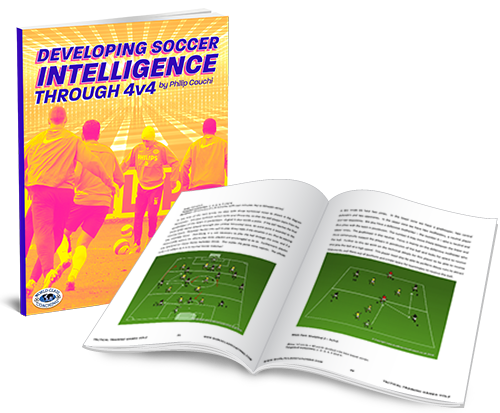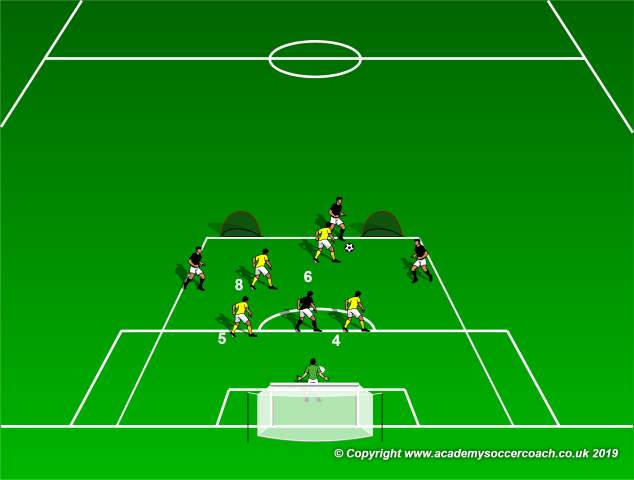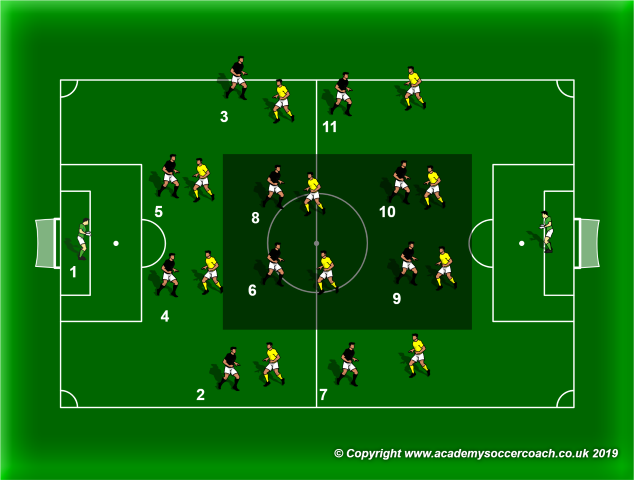WORLD CLASS COACHING
Developing Soccer Intelligence Through 4v4
By Philip Cauchi

Table of Contents
PART TWO
Various Uses of 4v4
4v4 as Part of the 11v11 Game
Various uses of the 4v4
The 4v4 game can be used for different purposes. It could be used as a tactical guideline to develop beginners. It may also be used to develop technique or to refine and develop group tactical concepts with more advanced players. Furthermore, the 4v4 if properly utilised can serve as a soccer specific conditioning tool!
The 4v4 is the smallest manifestation of the 11v11 game where realism is still present despite the smaller number of players. Within this game setup, basic positional reference can be applied and therefore the development of a particular principle of play could be nourished and transferred to the global game (Hyballa and Te Poel, 2012). Similar problems and the solutions available in an 11v11 game are also found in the 4v4 version (Jankowski, 2016).
In the 4v4 version all the moments and phases of the game are present. When working on establishing a particular playing style, adjusting the pitch dimensions will definitely help in developing the players’ habits and also aid in their ability to recognise specific cues within the environment. Playing in smaller numbers enables the game to recreate particular tactical situations itself and often. This setup makes it much easier for the coaches to pin point specific problems and highlight them for the players to understand and solve.
Dutch coach educator Dr Raymond Verheijen (2104) explains how a 4v4 practice (without goalkeepers) could be used to develop soccer specific performance. Using his soccer action language, Dr Verheijen explains how this simplified version of the game can either be used to develop more actions per minute (more pressing, more passing, more off-the-ball runs, etc.) by playing in a smaller area, or to maintain many actions per minute, thus working on maintaining a higher recovery power.
In a 4v4 game the players frequently find themselves in 1v1 situations. Although the frequency is not as high as in a 3v3 game, the options provided by the 4v4 game are more realistic. The team shape is more realistic as the principles of having height, depth and width are all present. Something which the 3v3 version lacks.
When playing the 4v4 it is important to design the context in which we want our players to learn from. For a more effective learning environment the problems presented in the 4v4 game must match the reality of the global game (Ford in Strudwick, 2016). Meaningful practices develop the players’ ability to read the game and perform unconscious automatic movements, habits to be more precise, which give our playing style an identity (Bordonau and Villanueva, 2018).

As more actions per minute can be achieved in a 4v4 game (Verheijen, 2014) if the playing area is quite small, technical competence is also developed. The number of touches each player has on the ball will be high. There will be more passes, more shots on goal, more dribbles, more tackles, more saves by the goalkeeper, etc. In a study done with the Manchester United’s under 9 team during the 2002-2003 season, Dr Nick Fenoglio analysed and compared the game of 4v4 with the 8v8 (Jankowski, 2016). As shown in the table hereunder the number of on the ball actions was much higher in the 4v4 than in the 8v8.
The 4v4 is also an excellent tool to refine the details about the relationship of particular sectors or inter-sectors within a team during a particular moment and phase of the game. It could be that we want to work on the communication links between our central defenders and the two central midfielders within a 1-4-4-2 system of play when our team is not in possession of the ball and the opponents are attacking from a central position. We want our players to frequently meet this problem in training. Using specifically designed practices we create the right environment where the problem is experienced by our players repeatedly during the session. The players will become more aware of the problem and recognise the need for more collaborative work to overcome this hurdle. In training, working on the problem using the 4v4 as a corrective tool might be more efficient than when working within an 11v11 in this case. The problem is clearly highlighted and the amount of repetition is high.
The below is a practice about working on a problem with the two central defenders and the two midfielders in a 1-4-4-2 system of play when the opponents are attacking from a central location and close to our goal. The coaching problem and solutions could be broken down as shown.
Problem: The two midfielders get pulled out of position when the opponents attack centrally.
Aim: Prevent the opponents from penetrating through the middle.
Macro principle of play: Retain compactness.
Sub-principle: Positioning of the two central defenders in relation to each other and to the two midfielders.
Sub-sub-principles: Marking stance, marking distance, way (how) to apply pressure on the ball and covering.

Description of the exercise: The attacking team lines up in a 3-1 formation of the 1-4-2-3-1 while the defending team lines up in a 1-2-2 formation representing the central low block of the team. The defending team aims to prevent the attacking team from scoring in regular goal, win the ball and score in the mini goals, as if simulating a counter attack.
4v4 – a fractal of the 11v11 game
The 4v4 is the smallest replication of the 11v11 game where the all the training processes could be used to improve performance in the global game. It is therefore of upmost importance that when designing the training process, the exercises chosen should replicate real match problematic situations. The players are the main actors as they are the ones who will be facing these problems and they will be the ones who must solve them during the game. In training situations the players should be immersed in their natural position with reference to specific moments, phases and even the part of the pitch they will be in.

In the above diagram we take the example of two systems of play mapped against each other theoretically on the tactics board – the 1-4-4-2 against the 1-4-4-2. We want to work on the creative phase of the build-up and to develop the relationship between our midfield and attack during this phase of play. For this purpose we will use a 4v4 game involving the players involved in such a situation.
As one of our macro principles of the playing style requires us to build-up play through the thirds, we will be using the midfield sector a lot during the construction of an attack. We would then focus on the positioning of the four midfielders during this phase thus developing the necessary communication links is a must. Through systemic repetition (Bordonau and Villanueva, 2018) when playing 4v4 we will enhance our playing style and therefore strengthen the desired behaviour of the players during the game.
In this 4v4 practice, teams are evenly matched so there will be a lot of 1v1 situations all over the training area. In this numerical equality there is no place for the players to hide or to relieve as when they are playing in a numerical advantage such as in a 4v4+2 neutrals. This constraint forces the players to think harder and smarter on how to create space both for themselves and for their teammates.


